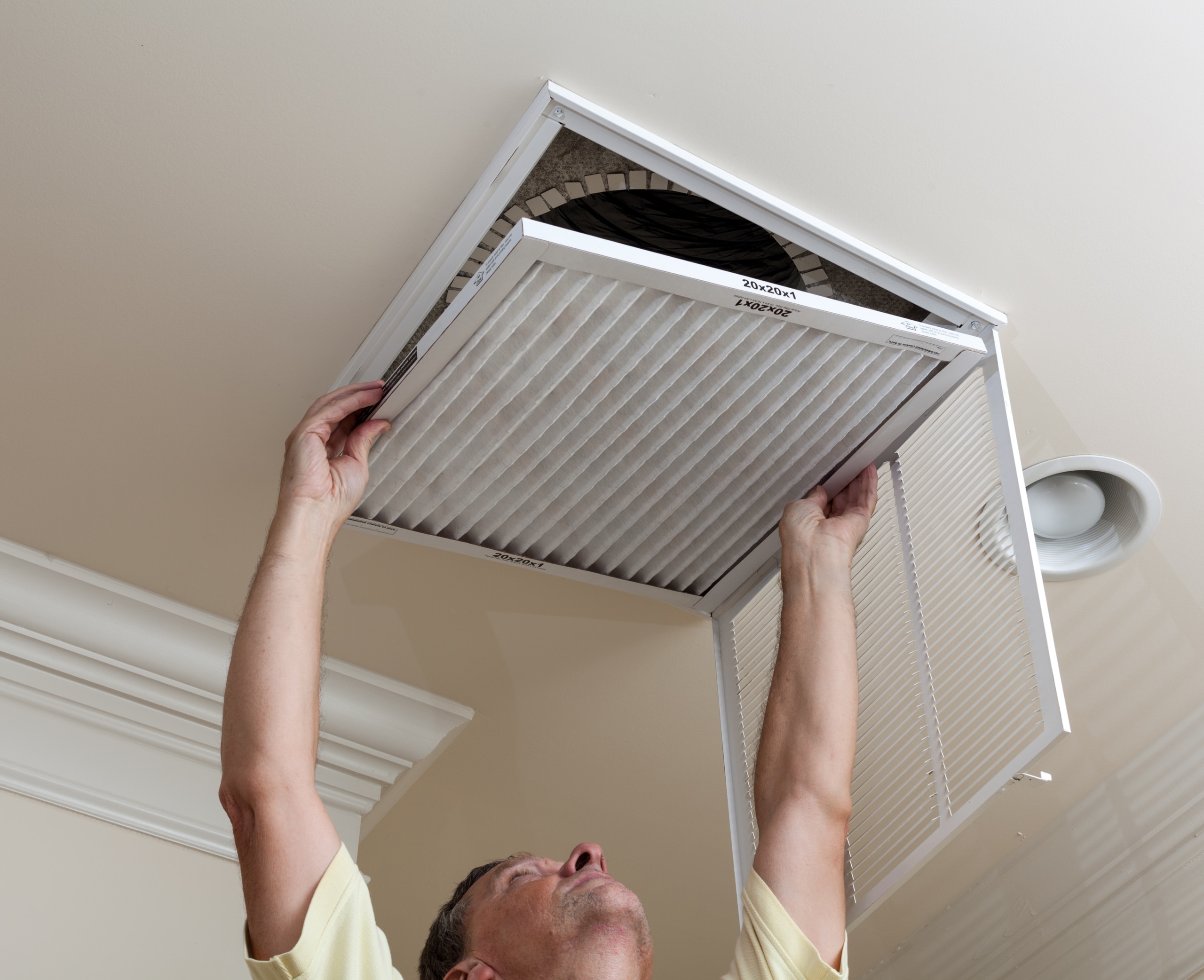HVAC filter replacement directly impacts home air quality. Air filters can trap allergens and contaminants, preventing them from circulating through your home’s air vents. Choosing the right air filter can be tricky, and an HVAC tech who understands your system can help.
Table of Contents
- The Impact of HVAC Filters on Indoor Air Quality
- Choosing The Right HVAC Filter for Your System and Needs
- How To Change an Air Filter
- Common HVAC Filter Myths
- Additional Tips for Improving Home Air Quality
- Indoor Air Quality FAQs
The Impact of HVAC Filters on Indoor Air Quality

Air pollution is quickly becoming one of our most significant health risks. Lung India calls it the world’s single biggest environmental health risk.[1] While air pollution affects you indoors and outdoors, pollution levels tend to be higher inside a home.
This difference is due to poor ventilation in modern homes, which leads to increased indoor air quality issues. While there are many ways to address indoor air quality problems, an HVAC filter is one of the best lines of defense. In fact, with the right filter, you can improve indoor air quality by as much as 60%.[2]
Air filters, especially HEPA air filters, trap most particles that are 0.3μm or larger. These microscopic airborne particles include bacteria and viruses that can make you sick. They also include dust mites and pet dander that can impact allergies. A filter stops them in their tracks, trapping them so they don’t continue circulating through your home.
Choosing the Right HVAC Filter for Your System and Needs
There’s no denying that HVAC filtration is essential, but not all filters are created equal. If you want to improve your home’s air filtration, you need to choose the right filter.
Understanding MERV Ratings
First, you need to understand how filters are rated. Every filter has a MERV rating. This rating indicates how effectively it filters particles. The larger the MERV rating, the more effective your air filter is.
Choosing the Right HVAC Filter Type
Sometimes, your HVAC system will require a specific filter, but other times, you can choose based on your goals. Some common types include:
- Fiberglass air filters: Fiberglass air filters are affordable, disposable options. They allow the HVAC system to work very efficiently, and they can trap large particles. They aren’t great at trapping smaller particles, such as dust, so they may not protect against respiratory issues. These filters have MERV ratings of 4.
- Pleated air filters: These filters have pleats made of cotton or polyester. They’re more effective than fiberglass at trapping small particles. They can have MERV ratings between 5 and 8.
- Washable filters: Washable filters have a reusable filter medium. When they become dirty, you wash or vacuum them off and replace the filter once it’s dry.
- HEPA filters: HEPA stands for “high-efficiency particulate air” and is the most effective at trapping dust and debris. HEPA filters trap up to 99.97% of particles that are 0.3μm or larger. They have a MERV of 11 or higher.
- UV filters: These filters don’t’ trap particles. Instead, they are part of the HVAC system that uses UV radiation to kill living microorganisms, like bacteria and viruses. They often work in conjunction with other types of filters to further improve indoor air quality.
Selecting the Right Filter Size
HVAC air filters vary by size and type of filter material. You’ll want to ensure you get the right size for your home, which typically depends on your HVAC system. Most standard home HVAC systems take one- and two-inch filters, while larger systems can take three to six-inch filters. Choose an air filter that fits tightly into the HVAC unit to prevent air and debris from escaping around the edges.
Considering Special Circumstances
Sometimes, special circumstances, such as living in an old, dusty home or having pets, can change the type of air filtration you need. In addition, having pet hair and excessive dust can lessen the time between filter changes.
Contact Air Filtration Experts for Help
Call an air filtration expert if you need help choosing the right air filter. Hoffmann Brothers and our team of HVAC pros can help you select the right air filter for your home and indoor air quality goals.
How to Change an Air Filter
When your air filter needs to be changed, you can typically handle the job independently. While we’re happy to do this for you, and while it is a part of your annual maintenance plan, you may need to handle some changes on your own.
Before you begin, turn off the furnace. You don’t want unfiltered air running through the system while you do this job.
To change your air filter, locate the filter housing and remove the old one. You might have to remove a cover to access the filter, or it may just slide out. Take note of which direction it sits in the unit.
After removing the old filter, slide the new one in, facing the same direction as the old one. If you’re unsure about the direction, point the arrow on the filter away from the blower so the air flows through the furnace. Turn the heater back on, and you’re ready to go.
Common Filter Replacement Mistakes To Avoid
As you change your air filter, watch out for these common mistakes:
- Facing the air filter in the wrong direction
- Choosing the incorrect size air filter
- Choosing an air filter that is too efficient for your system
- Waiting too long to change the air filter
Common HVAC Filter Myths

As you take charge of your home’s indoor air quality through improved HVAC filtration, make sure you don’t fall victim to these common myths:
- Replace your air filter every 30 days: While this is a good rule of thumb for some homes, it may be too frequent for others. 1″ filters in homes that have pets, burn candles, etc. may need to have their filter changed every 30 days, but larger sized filters may only need to be changed every 6 months. It’s best to check the manufacturer recommendations, or contact us for an expert HVAC pro opinion.
- Higher MERV ratings are always better: Higher MERV ratings mean better filtration, but if you go too high, your furnace will have to work too hard to move air through your home. Anything above 12 can be hard on your furnace, and a MERV of between 8 and 12 is usually plenty of filtration for the average home.
- Washable filters are the best choice: While it’s nice not to buy filters, washable filters tend to have very low MERV ratings, so you may not achieve excellent home air quality with one.
- Filter changes mean I don’t need HVAC maintenance: An annual tune-up of your HVAC system is always important. While filter changes will help with indoor air quality and the function of your heating and cooling systems, they won’t prevent normal wear and tear.
Additional Tips for Improving Home Air Quality
Your home’s air filter is one of the best ways to prevent indoor air quality issues, but it’s not the only thing you can do. Consider these additional tips to make your home’s indoor air as clean as possible.
- Control humidity levels: According to the EPA, ideal indoor air humidity is between thirty and fifty percent.[3] Use humidifiers and dehumidifiers to adjust this level as needed.
- Avoid burning: Candles and fires can add smoke to the indoor air. If you do have a fireplace, make sure it is properly ventilated. Avoid candles and other open flames; do not let people smoke inside your home.
- Test: Test your home for radon or similar dangerous gasses that can contribute to indoor air quality problems.
- Dust regularly: Use a damp cloth to remove dust from surfaces in your home. This will keep it from entering the HVAC system and circulating through your home.
- Vacuum regularly: Use a vacuum with a strong filter to vacuum regularly to suck up dust and debris before it gets into your air.
Indoor Air Quality FAQs
When you start to notice increased problems with respiratory health or layers of dust building up in your home or around your air vents, it’s time for an air quality check.[4]
While pet dander and dust can all cause problems with indoor air quality, the most common issue is poor ventilation in the home. When you have good ventilation combined with good filtration, many indoor air quality problems disappear.
Air conditioners don’t remove indoor air pollution without additional help, such as an air purifier or an HVAC filter. However, they improve humidity levels in the home, which can help with indoor air quality.
Indoor air quality monitors can give you a snapshot of the home’s indoor air quality. You can also hire an HVAC professional to perform indoor air quality testing.
Filter prices vary depending on manufacturer. However, it’s also a task included with your annual HVAC system maintenance check.
When your HVAC filter has gone bad, it will appear gray or black. You’ll also be able to see dust and other debris on it.



